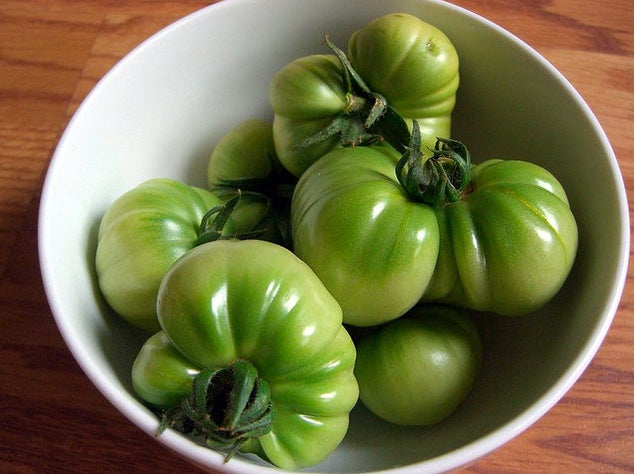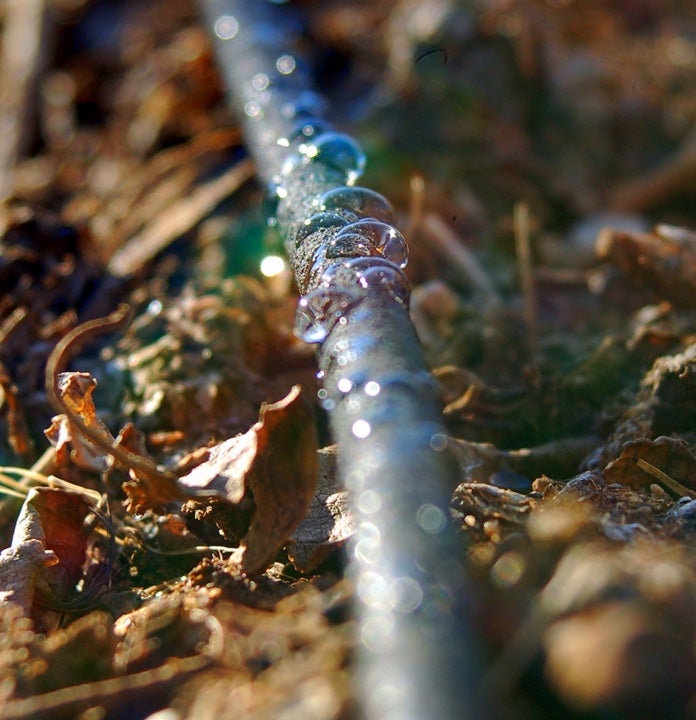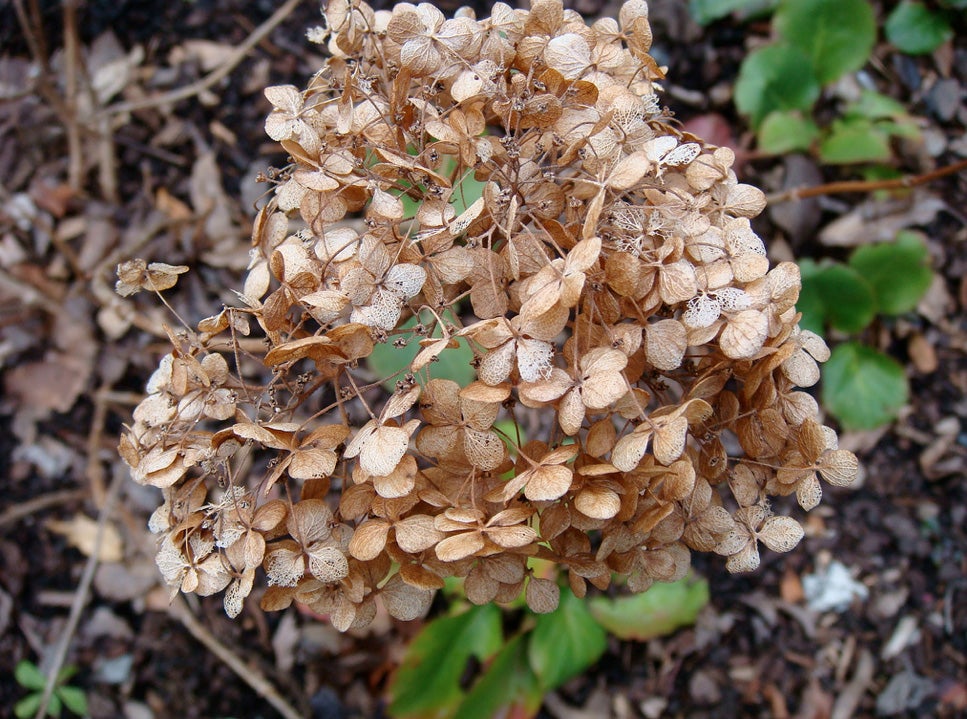Make a batch of home-made compost!
ListenMike explains how to care for indoor potted plants through dry winter months, what to do if your tomatoes are still green at the end of the growing season, the healthiest way to remove old blossoms from flowering bushes, the secret to keeping your tuberose happy, another way to deter blue heron, how to care for young trees properly and how to make compost at home.
Question of the Week:
“I just watched the video of your TEDx talk on composting fall leaves and found it to be tremendously enlightening. Can you do the same thing with lawn clippings and/or hay?” — Cenzo in Finland, Pennsylvania
Learn how to make compost »
Highlights from show for October 5, 2013:
Caring for indoor potted plants through dry winter months
Daniel from Philadelphia is wondering about the health of his lemon tree. The potted lemon tree has been growing well indoors under a skylight until recently when some (but not all) of the leaves have started turning yellow. When Mike asks about how frequently the plant is watered, he suspects that the lemon tree is not getting what it needs because of the type of pot it’s growing in. Mike explains: “[The unglazed ceramic pot is] wicking its moisture into the air, and your air is going to get very dry over the winter. Your timing could not be better. If you were a brave man, I would suggest you repot it into a plastic pot simply so that the water loss would not be so dramatic. [In an unglazed ceramic pot] you are going to have to water more than less, especially if your house gets dry … If your house gets dry, it’ll dry that houseplant soil out. I was afraid you were overwatering, but you might be underwatering.”
Are your tomatoes still green? Ripen them indoors!
Becky had a chilly growing season in the Allegheny foothills in New York. This summer she had only ten days that went over 80 degrees! The cooler weather has not helped her garden and now in October she’s finding that all of her tomatoes are still green. The plants are generally healthy and still producing flowers, but the chill is slowing their ripening. Mike advises Becky to remove any new flowers that her plants are producing. He says: “Those flowers don’t have any chance of becoming ripe fruits, and all they’re doing is taking energy from the plant. So pull off any new flowers. Quite honestly, on big plants like Mortgage Lifter and Brandywine, if there’s just little pibbly baby tomatoes — pull those off too.” Mike goes on to explain that for Becky to grow successfully next season, she needs to find a way to get heat to her plants early on. For now, her best bet is to salvage what she can out of her end-of-season garden. Mike recommends: “If there’s gonna be a hard freeze, bring the tomatoes in that night. Any tomato that is full size will ripen up indoors. Keep it away from direct light, just leave it sitting out on the kitchen counter … and they will ripen.”
“If there’s gonna be a hard freeze, bring the tomatoes in that night. Any tomato that is full size will ripen up indoors. Keep it away from direct light, just leave it sitting out on the kitchen counter … and they will ripen.”
Mike McGrath
-

Photo by Flickr user Will Luo
It’s OK to remove dead blossoms but it’s not OK to prune the plant
Andrew from West Point, New York has hydrangeas that have run their course and are now covered with dead blossoms. He has heard both good and bad things about deadheading the blossoms and so he’s calling Mike for clarification. Mike explains that removing the spent blossoms is OK as long as it doesn’t tread into a full pruning treatment: “I think you might be confusing good advice with the advice you’re after — and the good advice is certainly don’t be cutting back your hydrangea plants themselves … But that is not deadheading. Deadheading benefits virtually every plant. Cutting the hips off of your spent roses is not the same as cutting your roses back, which would stimulate growth and expose them to winter injury. So as long as you are just going to be doing the tidy-up — that is, cutting off all those big, browned balls and not messing with the plant itself, you’re golden.”
To keep your tuberose happy, keep it warm
Patrice from Santa Barbara, California just purchased a tuberose and is looking for tips to keep this plant happy and healthy. Mike says: “There’s two secrets to this plant that I know of. One is that it really loves warm temperatures. In the future, your job is to keep it warm. And if the temperatures drop below, you know say 45 degrees in the winter time, and if you start to see any yellowing of the leaves, you probably do want to bring it inside. In future seasons these plants typically need about four months of warm weather to produce their flowers, so they’re kinda late-summer bloomers in non-tropical areas.” Mike’s other secret for this plant is that it favors acidic soil, and he recommends that should the tuberose be repotted, that it be transplanted with acidic soil.
Watering on an incline? Try drip irrigation
Chris from Baltimore, Maryland has what he describes as a “two-story bunker” in his backyard that acts as a sound barrier and privacy screen to the highway on the other side of his yard. He’s having trouble watering the grass on this steep incline because the water just runs down the side, creating a muddy pool at the base of hill. Mike advises Chris to get rid of the high impact sprinkler he’s using and instead opt for drip irrigation. “You’ll see there’s several different types of drip irrigation. There’s little pieces of tubing that have holes punched in them, there’s little pieces of tubing that sweat, and then there’s what’s called ‘irrigation tape’ that is very flat to the ground and I believe just has the holes on one side. So that would always just be down in the grass. When you mow, it wouldn’t be an issue. … [Drip irrigation] would always be the most efficient use of your water, it’s going to soak into the soil almost by definition. And run it in the morning — that’s when the grass, almost like the pores of the grass, would be open to receive moisture and they’ll get the most bang for the shortest run. But if it doesn’t rain for a week, you cold let this drip irrigation run for, like, several hours in the morning once a week, and I don’t think you’re going to get any puddling and you’ll get much more even grass grow.”
“You’ll see there’s several different types of drip irrigation. There’s little pieces of tubing that have holes punched in them, there’s little pieces of tubing that sweat, and then there’s what’s called ‘irrigation tape’ that is very flat to the ground and I believe just has the holes on one side … [Drip irrigation] would always be the most efficient use of your water, it’s going to soak into the soil almost by definition.”
Mike McGrath
-

Photo by Flickr user Joby Elliott
An alternate method to deterring great blue heron
Tom from Haverford, Pennsylvania called in to follow up on a previous caller’s question about how to keep great blue heron out of fish ponds. Mike had advised the previous caller to install a motion activated sprinkler, but Tom has a more effective tactic to keep this particular pest at bay. Tom explains: “Pound stakes into the ground around the perimeter [of the pond], about every two feet, about 30 inches high, and then from the stakes you create a grid of fishing monofilament about two feet square. And so when the bird approaches, he bumps into the monofilament and that wakes him up or spooks him. He knows that if he gets under it and walks into the pond, he cannot do his normal exit, which is to fly away.”
Caring for young trees
Peter from Vandalia, Ohio is concerned about the magnolia he planted in the spring. He cared for it properly through the spring and most of the summer, but then neglected it during a bad drought in August. He’s calling in to ask Mike if there’s anything he can or should do for the tree to protect it through the winter season. Mike says that the neglect may have stressed the magnolia a bit, but it’s probably fine. He recommends to keep watering the tree during dry times, explaining: “The best way to water a young tree — this is just for general information — is not to pour lots of water on it all at once, because a lot of that doesn’t get to the roots zone. But it is to drag a hose out there and let it drip gently at the base for a couple of hours.”
WHYY is your source for fact-based, in-depth journalism and information. As a nonprofit organization, we rely on financial support from readers like you. Please give today.







